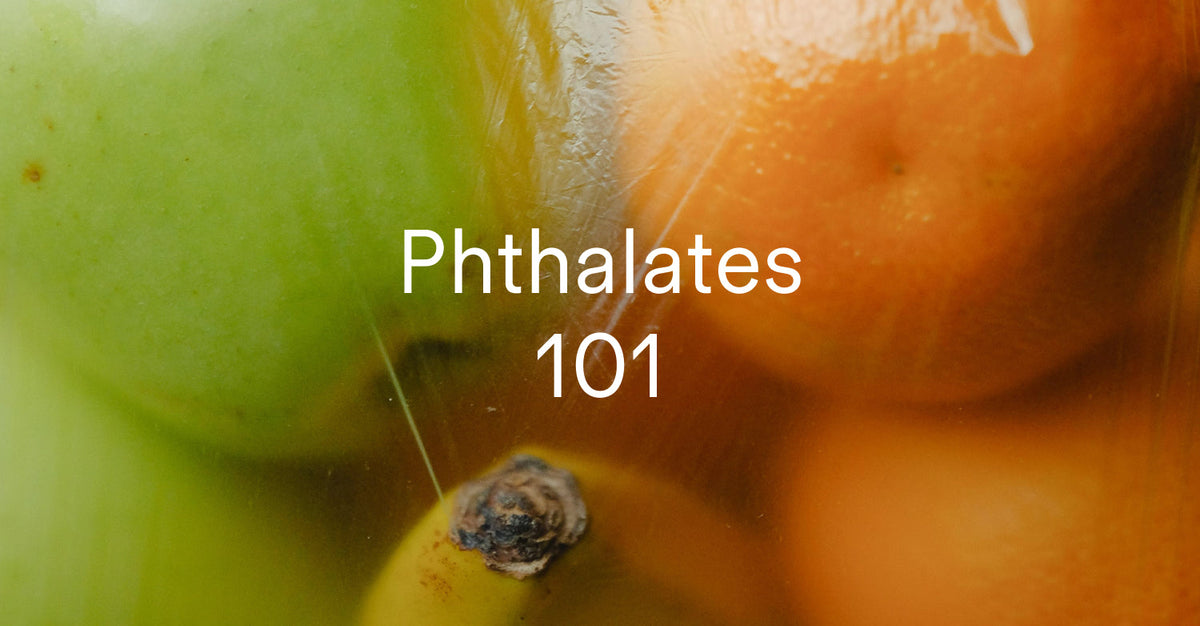

Every day, Americans lather up with phthalates, they decorate their homes, wrap their food, paint their nails, and even wash their clothes with them. This chemical is so widespread—found in everything from food containers, fragrances, personal care products, consumer products, cleaning products, and children’s toys, to building materials such as vinyl flooring and shower curtains—that it’s earned the nickname “the everywhere chemical.” Phthalates are also commonly used in the food industry, including food processing and packaging. They are considered hazardous chemicals and are a source of ongoing health concerns due to their potential risks to human health. But how does phthalate exposure impact our health, and are there practical ways to reduce it? Let’s dive into the science to find out.
Looking to better understand how environmental factors, lifestyles, and habits may be affecting your rate of aging? Benchmark and track your epigenetic age overtime with the TallyAge Test.

What are phthalates and why are they harmful?
Phthalates are synthetic chemicals often used to make plastics more flexible and durable. However, their use extends beyond plastics. These chemicals can also be found in personal care products, household items, food packaging, food contact materials and processing materials used in the food industry, and more. In the US alone, over 340 million pounds of phthalates are consumed annually [1]. The presence of phthalates in food packaging, food contact materials, and processing materials has led to concerns about phthalates in food and their widespread presence in the food supply. Certain phthalates, including ortho phthalates and diethyl phthalate, are commonly used as plasticizers in these products.
Despite their effectiveness as a cheap industrial solution, phthalates are not without risks. Scientific studies have linked these chemicals to various health problems. Phthalates are classified as toxic chemicals and hazardous substances, and their use in food handling and packaging is a subject of regulatory scrutiny.

Hormonal disruptions
Phthalates are endocrine disruptors, meaning they interfere with reproductive hormones like testosterone and estrogen [2, 3]. These chemicals can also alter hormone levels and disrupt reproductive development, in addition to disrupting hormones responsible for regulating critical bodily functions such as metabolism, energy levels, blood sugar, and stress responses [4].
In adult men, repeated exposure to phthalates has been linked to an increased risk of abnormal sperm quality and potential DNA damage in sperm [5]. Phthalates can also adversely affect the male reproductive system, increasing the risk of birth defects and hormonal disruptions. For women, these endocrine-disrupting chemicals can lead to irregular menstrual cycles and may elevate the risk of early menopause [6, 7]. Pregnant women are particularly vulnerable to phthalate exposure, which has been associated with adverse pregnancy outcomes such as pregnancy loss and preterm birth.
A systematic review of available studies highlights how phthalates affect hormone levels, reproductive development, and increase the risk of birth defects.
Obesity
As endocrine disruptors, phthalates can significantly affect metabolism and body weight. Emerging research indicates a link between phthalate exposure and accelerated fat gain, particularly in middle-aged women [8]; notably, high concentrations of phthalates have been detected in some processed foods, which may contribute to increased exposure and metabolic risk. Additionally, phthalates have been found to increase both the number and size of fat cells, contributing to weight gain and the development of obesity [9].
Diabetes
Research has identified a link between phthalates and metabolic markers associated with insulin regulation. Specifically, studies show that the presence of phthalate metabolites in urine is correlated with reduced insulin sensitivity [10]. Furthermore, one study suggests that exposure to phthalates may pose an even greater risk of developing diabetes than obesity [11].
Heart disease
Although the link between phthalate exposure and heart disease is not yet fully understood, research suggests a notable association with conditions like high blood pressure and atherosclerosis (plaque buildup in the arteries) in adults [12]. One study specifically highlighted the impact of di-2-ethylhexyl-phthalate, a type of phthalate, on heart rate variability and cardiovascular reactivity—key indicators of autonomic balance and stress resilience. These factors play a significant role in determining the risk of cardiovascular disease [13].
How phthalates may be aging us

Do phthalates accelerate aging? While more human research is needed, animal studies suggest that phthalate exposure can damage DNA, alter gene expression, impair mitochondrial function (a key aspect of aging), and increase oxidative stress. These effects may collectively accelerate aging and raise the risk of age-related diseases [15, 16, 17, 18, 19].
In humans, phthalates have been found to influence epigenetics—modifiable chemical modifications that regulate how genes are expressed. Research shows that even low-level phthalate exposure during pregnancy or early life can disrupt DNA methylation, potentially causing lasting changes in gene expression [18]. These epigenetic changes are linked to an increased risk of neural and immune disorders, infertility, and chronic diseases. Alarmingly, some of these effects may be passed down to future generations.
Science-backed tips to limit phthalate exposure

While it’s impossible to completely remove every phthalate-containing product from your life, taking proactive steps to reduce your exposure—such as practical ways to avoid phthalates in everyday life—can make a meaningful difference. Reducing plastic waste can also help limit the release of phthalates and other hazardous chemicals into the environment.
Here are some science-backed steps to limit exposure. Minimizing contact with plastic packaging is especially important, as it can be a significant source of phthalate exposure.
Check personal care product labels
When shopping for cosmetics, shampoos, or lotions, look for labels that say “phthalate-free.” Be especially cautious of the term “fragrance” on ingredient lists, as it often conceals the presence of phthalates. Products like hair gels, soaps, hair sprays, nail polish, perfumes, and body lotions are common culprits, as phthalates are frequently used to make fragrances last longer. [20].
Choose safer plastics
While avoiding plastics entirely might be impossible, you can take a simple step by checking plastic labels. Plastics that contain phthalates are often marked with the recycling code “3” or labeled as “PVC.” Whenever possible, opt for safer alternatives like glass, ceramic, or stainless steel [20].
Avoid heating plastics
Research suggests that phthalates can be released when plastics are heated in the microwave [21]. Even phthalate-free plastic containers may release other harmful chemicals when exposed to heat. To minimize risk, avoid microwaving food in plastic containers or covering hot food with plastic wrap. Instead, transfer your meals to ceramic or heat-resistant glass dishes before heating.
Wash your hands often
Phthalates, like DEHP, can enter your body through hand-to-mouth contact or by transferring to food. The good news? Washing your hands with soap and water can remove over 90% of DEHP, compared to just 10% when using water alone [22]. This highlights why it’s essential to wash your hands thoroughly, especially before eating.
Ventilate and clean your home
Phthalates, commonly found in household items like vinyl flooring and synthetic furniture and cleaning products, often accumulate in indoor air and dust. Research has revealed that roughly 90% of household dust samples contain high levels of ten harmful chemicals, including phthalates [23]. To reduce your exposure, regularly vacuum using a HEPA filter and ensure your home is well-ventilated.
Avoid ultra-processed foods and excessive food packaging
Consuming packaged and ultra-processed items like hamburgers, French fries, and ice cream, as well as dairy products and other foods that may be contaminated during food processing and handling, can significantly increase your exposure to phthalates compared to eating unprocessed or minimally processed foods [24]. Studies have identified nine phthalates commonly used as plasticizers in food packaging and processing materials, which can leach into food. Additionally, dining out poses a higher risk of phthalate exposure than eating meals prepared at home [25]. Studies show that individuals who frequently eat out—whether at restaurants or fast-food establishments—have phthalate levels nearly 35% higher than those who primarily consume food sourced from grocery stores. Food processing and food handling practices also play a significant role in increasing phthalate contamination of foods. Plastic toys, especially soft vinyl and older plastic toys used by children, can also be a significant source of phthalate exposure.
Filter your water
Phthalates can seep into drinking water. To reduce exposure, consider using water filtration systems specifically designed to remove phthalates. Effective options include under-the-sink reverse osmosis systems, nano-filtration systems, and granular activated carbon filters [26]. Additionally, look for systems certified under NSF/ANSI Standard 58, which are rigorously tested to eliminate phthalates and other harmful contaminants [27].
What are phthalates?
Phthalates are synthetic chemicals used to make plastics more flexible and durable. They are also found in personal care products, household items, food packaging, and materials used in food processing.
How do phthalates affect human health?
Phthalates are endocrine disruptors that can interfere with hormones, contribute to obesity, impair insulin sensitivity, increase the risk of heart disease, and may even be linked to premature death. They also potentially accelerate aging and can cause reproductive harm in both men and women.
How can I reduce my exposure to phthalates?
You can limit exposure by choosing phthalate-free personal care products, avoiding plastics labeled with recycling code “3” or “PVC,” not microwaving food in plastic containers, washing hands frequently with soap, cleaning your home regularly, avoiding ultra-processed foods, and filtering your drinking water.
Recommended Supplements
Citations
[1] Wang, Y., & Qian, H. (2021). Phthalates and Their Impacts on Human Health. Healthcare, 9(5), 603. https://doi.org/10.3390/healthcare9050603
[2] University of Washington, Department of Environmental and Occupational Health Sciences. (2014). Healthcare provider guide: Phthalates and bisphenol A. Retrieved from https://deohs.washington.edu/sites/default/files/documents/Plastics_Provider_Factsheet_Feb_2014.pdf
[3] Nobles, C. J., Mendola, P., Kim, K., Pollack, A. Z., Mumford, S. L., Perkins, N. J., Silver, R. M., & Schisterman, E. F. (2023). Preconception Phthalate Exposure and Women's Reproductive Health: Pregnancy, Pregnancy Loss, and Underlying Mechanisms. Environmental health perspectives, 131(12), 127013. https://doi.org/10.1289/EHP12287
[4] Hlisníková, H., Petrovičová, I., Kolena, B., Šidlovská, M., & Sirotkin, A. (2020). Effects and Mechanisms of Phthalates’ Action on Reproductive Processes and Reproductive Health: A Literature Review. International Journal of Environmental Research and Public Health, 17(18), 6811. https://doi.org/10.3390/ijerph17186811
[5] Hauser, R., Meeker, J. D., Duty, S., Silva, M. J., & Calafat, A. M. (2006). Altered semen quality in relation to urinary concentrations of phthalate monoester and oxidative metabolites. Epidemiology (Cambridge, Mass.), 17(6), 682–691. https://doi.org/10.1097/01.ede.0000235996.89953.d7
[6] Endocrine Society. (n.d.). Impact of EDCs on reproductive systems. Retrieved from https://www.endocrine.org/topics/edc/what-edcs-are/common-edcs/reproduction
[7] Ziv-Gal, A., Gallicchio, L., Chiang, C., Ther, S. N., Miller, S. R., Zacur, H. A., Dills, R. L., & Flaws, J. A. (2016). Phthalate metabolite levels and menopausal hot flashes in midlife women. Reproductive Toxicology (Elmsford, N.Y.), 60, 76. https://doi.org/10.1016/j.reprotox.2016.02.001
[8] Peng, M. Q., Karvonen-Gutierrez, C. A., Herman, W. H., Mukherjee, B., & Park, S. K. (2022). Phthalate exposure is associated with more rapid body fat gain in midlife women: The Study of Women’s Health Across the Nation (SWAN) Multi-Pollutant Study. Environmental Research, 216(Pt 3), 114685. https://doi.org/10.1016/j.envres.2022.114685
[9] Apau, J., Sefah, W., & Adua, E. (2020). Human contact with phthalates during early life stages leads to weight gain and obesity. Cogent Chemistry, 6(1). https://doi.org/10.1080/23312009.2020.1815273
[10] Mariana, M., & Cairrao, E. (2023). The Relationship between Phthalates and Diabetes: A Review. Metabolites, 13(6), 746. https://doi.org/10.3390/metabo13060746
[11] Dirinck, E., Dirtu, A. C., Geens, T., Covaci, A., Van Gaal, L., & Jorens, P. G. (2015). Urinary phthalate metabolites are associated with insulin resistance in obese subjects. Environmental Research, 137, 419-423. https://doi.org/10.1016/j.envres.2015.01.010
[12] Mariana, M., & Cairrao, E. (2020). Phthalates Implications in the Cardiovascular System. Journal of Cardiovascular Development and Disease, 7(3), 26. https://doi.org/10.3390/jcdd7030026
[13] Rafael Jaimes, I., Swiercz, A., Sherman, M., Muselimyan, N., Marvar, P. J., & Posnack, N. G. (2017). Plastics and cardiovascular health: Phthalates may disrupt heart rate variability and cardiovascular reactivity. American Journal of Physiology - Heart and Circulatory Physiology, 313(5), H1044. https://doi.org/10.1152/ajpheart.00364.2017
[14] NYU Langone Health. (2021). Deaths linked to 'hormone disruptor' chemical costs billions in lost U.S. productivity. NYU Langone News. https://nyulangone.org/news/deaths-linked-hormone-disruptor-chemical-costs-billions-lost-us-productivity
[15] Caldwell, J. C. (2012). DEHP: Genotoxicity and potential carcinogenic mechanisms—A review. Mutation Research/Reviews in Mutation Research, 751(2), 82-157. https://doi.org/10.1016/j.mrrev.2012.03.001
[16] Roy, D., Morgan, M., Yoo, C., Deoraj, A., Roy, S., Yadav, V. K., Garoub, M., Assaggaf, H., & Doke, M. (2015). Integrated Bioinformatics, Environmental Epidemiologic and Genomic Approaches to Identify Environmental and Molecular Links between Endometriosis and Breast Cancer. International Journal of Molecular Sciences, 16(10), 25285-25322. https://doi.org/10.3390/ijms161025285
[17] Caldwell, J. C. (2012). DEHP: Genotoxicity and potential carcinogenic mechanisms—A review. Mutation Research/Reviews in Mutation Research, 751(2), 82-157. https://doi.org/10.1016/j.mrrev.2012.03.001
[18] Singh, S., & Li, S. S. (2012). Epigenetic Effects of Environmental Chemicals Bisphenol A and Phthalates. International Journal of Molecular Sciences, 13(8), 10143-10153. https://doi.org/10.3390/ijms130810143
[19] Fan, X., Zhang, D., Hou, T., Zhang, Q., Tao, L., Bian, C., & Wang, Z. (2024). Mitochondrial DNA Stress-Mediated Health Risk to Dibutyl Phthalate Contamination on Zebrafish (Danio rerio) at Early Life Stage. Environmental science & technology, 58(18), 7731–7742. https://doi.org/10.1021/acs.est.3c10175
[20] Zero Breast Cancer. (n.d.). Phthalates: The everywhere chemical. National Institute of Environmental Health Sciences. Retrieved from https://www.niehs.nih.gov/sites/default/files/research/supported/translational/peph/resources/assets/docs/phthalates_the_everywhere_chemical_zero_breast_cancer_508.pdf
[21] Moreira, M. A., André, L. C., & Cardeal, Z. L. (2013). Analysis of phthalate migration to food simulants in plastic containers during microwave operations. International journal of environmental research and public health, 11(1), 507–526. https://doi.org/10.3390/ijerph110100507
[22] Lin, I. D., Wu, F., Kou, S., Huang, Y., Shiea, J., & Wu, T. (2017). Removal of Diethylhexyl Phthalate from Hands by Handwashing: Evidence from Experimental N-of-1 and Crossover Designs. Scientific Reports, 7, 454. https://doi.org/10.1038/s41598-017-00581-2
[23] Milken Institute School of Public Health. (2016). Potentially harmful chemicals widespread in household dust. The George Washington University. https://publichealth.gwu.edu/potentially-harmful-chemicals-widespread-household-dust
[24] Buckley, J. P., Kim, H., Wong, E., & Rebholz, C. M. (2019). Ultra-processed food consumption and exposure to phthalates and bisphenols in the US National Health and Nutrition Examination Survey, 2013–2014. Environment International, 131, 105057. https://doi.org/10.1016/j.envint.2019.105057
[25] Milken Institute School of Public Health. (2018). Dining out associated with increased exposure to harmful chemicals called phthalates. The George Washington University. https://publichealth.gwu.edu/dining-out-associated-increased-exposure-harmful-chemicals-called-phthalates
[26] Bodzek, M., Dudziak, M., & Luks-Betlej, K. (2004). Application of membrane techniques to water purification. Removal of phthalates. Desalination, 162, 121-128. https://doi.org/10.1016/S0011-9164(04)00035-9
[27] NSF International. (n.d.). Certified product listings for lead reduction. Retrieved from https://info.nsf.org/Certified/dwtu/listings_leadreduction.asp











